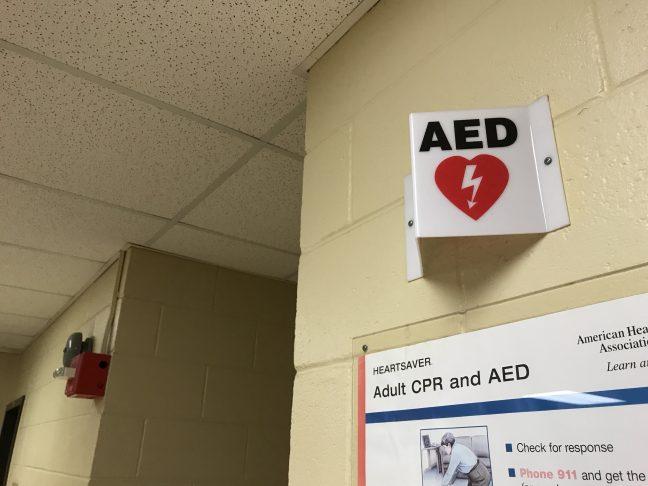While many of the residence halls at University of Wisconsin are decked out with free wifi, fully furnished rooms and well-designed spaces for studying and socializing, most lack the device that could mean the difference between life and death for someone experiencing sudden cardiac arrest.
Across UW’s 388 buildings, 95 are equipped with Automatic External Defibrillators, Environmental Health Manager Jeff Schiller said. But of the 219 total AEDs, only two are installed in the campus’ 19 residence halls.
According to the American Heart Association, the use of an AED, along with CPR, is the only way to restore a person’s heart rhythm to normal in many cases of cardiac arrest and can double a victim’s chance of survival.
The portable devices are typically carried in ambulances, police vehicles and installed on the walls of highly-trafficked public areas. They send electric shocks through the chest and into the heart, potentially allowing a normal heartbeat rhythm to resume following a sudden cardiac arrest, according to AHA.
Time is of the essence — for every minute a normal heartbeat isn’t restored, a victim’s chance of surviving drops by 7 to 10 percent, according to the AHA.
Dejope Hall and Chadbourne Hall are currently the only residence halls with AEDs, but a third is slated to be installed in Elizabeth Waters Hall once an exact location can be determined, UW Housing spokesperson Brendon Dybdahl said in an email to The Badger Herald.
Student heart health organization Cardiac on Campus bought and donated Chadbourne’s AED, Dybdahl said. The organization will also buy Liz Water’s AED.
Cousins Brittany Derynda and Jessie Miller co-founded Cardiac on Campus in 2015 after the sudden cardiac death of Derynda’s 20-year-old brother. The organization raises both awareness for heart health and money for AEDs and free CPR classes for UW students through fundraising events like its Red Tutu Trot 5k in the fall.
Among UW System Schools, Derynda said UW is “behind the curve” when it comes to sudden cardiac arrest preparedness. AEDs are not only necessary for students but also the parents, grandparents and faculty who traffic residence halls in large numbers.
Of the 13 UW System schools, seven have AEDs installed in the majority of its residence halls. UW-Milwaukee, UW-La Crosse, UW-River Falls and UW-Stevens Point have AEDs installed in every one of its residence halls. UW-Eau Claire (11 out of 14), UW-Whitewater (nine out of 14) and UW-Platteville (11 out of 12) have AEDs installed in most.
Conversely, six schools including UW-Madison, don’t have AEDs installed in many of its residence halls. One of UW-Green Bay’s 11 residence halls is equipped, while UW-Oshkosh, UW-Parkside, UW-Stout and UW-Superior have zero documentation of its AEDs online or on Pulse Point, an app which locates nearby AEDs.
Derynda said it’s a “blessing” UW-Madison hasn’t had an emergency like La Crosse’s, where an AED saved faculty member David Phipps following sudden cardiac arrest, to prompt its own campus-wide AED installation effort.
But Derynda added it’s the position of Cardiac on Campus as an organization promoting heart health that there is “no excuse” not to have buildings and staff be equipped for shorter response times.
“Our biggest push right now is let’s fix this preparedness issue and get all these dorm buildings and lecture buildings equipped with these AEDs and get people to know how to use them so that if there’s an event, it’s a good outcome as opposed to one of the bad outcomes,” Derynda said.
Like many university police departments, UW Police Department has AEDs in all of its squad cars. But despite UW’s detailed AED policy, each individual department still handles the funding for purchasing and updating AEDs, Schiller said.
It wasn’t until 2015 that Environment, Health and Safety — the department Schiller works for — was even involved with AEDs on campus. Prior to the department’s involvement, Schiller said each department would choose to purchase the units and put them on the wall, with no one on campus knowing whether or not the units were updated with new pads and batteries.
After volunteering to survey all AEDs on campus and write down all the units’ locations, expiration dates and serial numbers, Schiller said apps like Pulse Point now light up with AED icons.
But Schiller said he wishes the system was even more centralized through his department so he could buy the units — $1,700 each — in bulk, driving down the prices.
“Right now If we come across a unit that needs a pad replacement or a battery replacement, we notify the building manager and ask them to carry the burden to get those pieces of equipment updated. If it were standardized, we could do that ourselves,” Schiller said.
Dybdahl said UW Housing’s long-term plan is to have an AED at each of the campus’ six dining locations since these spots are centrally-located and most accessible to the university’s residents and guests. One is already installed in Gordon Avenue Market.
There are currently no plans to expand the number of AEDs in residence halls, Dybdahl added.
“Most of our other buildings have secured entrances that are only accessible to residents of that particular building, so access to an AED would be very limited,” Dybdahl said. “There are ongoing discussions about expanding the number of AEDs in University Housing buildings, but with 22 buildings there are some challenges with locations and cost to work through.”


